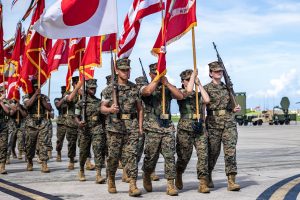In January 2023, the United States proposed changes to Marine deployments in Okinawa that include the stationing of missile-armed Marines across the island. At a joint meeting between Japanese and U.S. military officials, the idea was discussed at length, according to recent reporting.
Changes to the deployment of U.S. military aircraft at Okinawa have also recently taken place. Late last year the United States indicated that a dozen or so F-22s will be deployed to the U.S. military base in Kadena at the southern tip of the island of Okinawa. Rotation began to take place last month, as F-22s stationed in Germany were shifted to Okinawa to join Raptors that have been deployed in Okinawa since November 2022. The United States has acknowledged a need to retire aging F-15 fighters that had been stationed on the island.
Choices the United States military is making about the deployment of military aircraft and forces in Okinawa continue to evolve in ways that provide clues about what Japan and the United States are preparing for, given growing regional tensions with China.
Japan’s defense document, Defense of Japan, published in June 2022 highlights the need to deal with China’s growing use of unmanned aerial vehicles (UAVs) around the Japanese islands, including Okinawa. Concern about Chinese UAVs has grown as Chinese UAVs were tracked in late January completing flights close to Japan’s Sakishima and Miyako islands, part of a chain of islands not far from Taiwan. Intercepting Chinese military aircraft of this kind is likely to require a robust deployment of U.S. and Japanese military aircraft.
Defense researchers working in the United States have suggested that the use of manned fighter jets alone in Okinawa may be an outdated concept. The United States has stationed unmanned MQ-9 Reapers in Kyushu since October 2022 and Japan’s defense documents discuss using unmanned UAVs that complement manned fighters. The deployment of Japanese and U.S. aircraft to Japanese islands near Taiwan is growing diverse as China tests a range of aircraft in the area.
The stationing of missile-armed Marines also shows a wide focus given growing tensions in the Taiwan Strait. Marines stationed at Okinawa could play a key role in defending Japanese islands near Taiwan should a conflict break out. In the event of a China-Taiwan conflict, ensuring that Taiwan is not encircled and cut off would be key to supporting Taiwanese efforts to defend itself. Supplying the Taiwanese military in the way NATO and the United States have done for Ukraine would become difficult if the island is cut off.
Japanese defense documents continue to show a focus on building up defense capabilities on nearby islands like Nansei. This would mean ensuring that Japan can defend islands close to Taiwan where well-equipped U.S. Marines could play a key role in ensuring these islands remain defended. The deployment of these Marines in Okinawa indicates that the United States is potentially preparing for a drawn-out China-Taiwan conflict.
Japanese media has followed recent comments by U.S. Air Force General Mike Minihan closely. As part of a recently made public memo, Minihan highlighted the need for joint Japanese-U.S. forces to build a “fortified, ready, integrated, and agile Joint Maneuver Team ready to fight and win inside the first island chain” — the line of islands that includes Okinawa and Taiwan. These comments seem mirrored by an increasingly robust deployment of U.S. Marines and aircraft in Okinawa.
Both the United States and Japan are watching Chinese tensions with Taiwan closely. Back in 2019, Japan’s defense documents shied away from discussing Taiwan. A lot has changed since then, as Japan now has a dedicated discussion of defense planning connected to a possible conflict in the Taiwan Strait within its 2022 Defense of Japan document. Japan and the United States are actively taking note of changes occurring in China’s naval and air capabilities in the region.

































